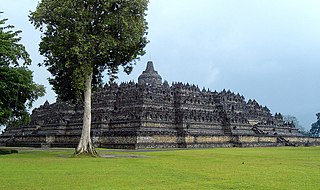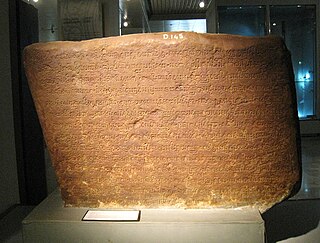
The 7th century is the period from 601 through 700 in accordance with the Julian calendar in the Christian Era.

Srivijaya, also spelled Sri Vijaya, was a Buddhist thalassocratic empire based on the island of Sumatra that influenced much of Southeast Asia. Srivijaya was an important centre for the expansion of Buddhism from the 7th to 11th century AD. Srivijaya was the first polity to dominate much of western Maritime Southeast Asia. Due to its location, Srivijaya developed complex technology utilizing maritime resources. In addition, its economy became progressively reliant on the booming trade in the region, thus transforming it into a prestige goods-based economy.
Datuk is a Malay title commonly used in Brunei, Indonesia, and Malaysia, as well as a traditional title by Minangkabau people in West Sumatra, Indonesia.

The Shailendra dynasty was the name of a notable Indianised dynasty that emerged in 8th-century Java, whose reign signified a cultural renaissance in the region. The Shailendras were active promoters of Mahayana Buddhism and covered the Kedu Plain of Central Java with Buddhist monuments, one of which is the colossal stupa of Borobudur, now a UNESCO World Heritage Site.

Kediri Kingdom was a Hindu-Buddhist Javanese kingdom based in East Java from 1042 until 1222. This kingdom is centered in the ancient city Dahanapura, despite the lack of archaeological remains, the age of Kediri saw much development in classical literature. Mpu Sedah's Kakawin Bharatayuddha, Mpu Panuluh's Gatotkacasraya, and Mpu Dharmaja's Smaradhana blossomed in this era. The kingdom's capital is believed to have been established in the western part of the Brantas River valley, somewhere near modern Kediri city and surrounding Kediri Regency.

The Mataram Kingdom ; also known as Medang Kingdom was a Javanese Hindu-Buddhist kingdom that flourished between the 8th and 11th centuries. It was based in Central Java, and later in East Java. Established by King Sanjaya, the kingdom was ruled by the Shailendra dynasty and Ishana dynasty.
A regency, sometimes incorrectly referred to as a district, is an administrative division of Indonesia, directly under a province and on the same level with city (kota). Regencies are divided into districts. The average area of Indonesian regencies is about 4,578.29 km2 (1,767.69 sq mi), with an average population of 670,958 people.

The Kedukan Bukit inscription is an inscription discovered by the Dutchman C.J. Batenburg on 29 November 1920 at Kedukan Bukit, South Sumatra, Dutch East Indies, on the banks of Tatang River, a tributary of Musi River. It is the oldest surviving specimen of the Malay language, in a form known as Old Malay. It is a small stone of 45 cm × 80 cm. This inscription is dated 1 May 683 CE. This inscription was written in Pallava script.

Tarumanagara or Taruma Kingdom or just Taruma was an early Sundanese Indianised kingdom, located in western Java, whose 5th-century ruler, Purnawarman, produced the earliest known inscriptions in Java, which are estimated to date from around 450 CE.

Samaratungga was the head of the Sailendra dynasty which ruled the Mataram Kingdom and Srivijaya in the 8th and 9th centuries. He was the successor of King Indra, and his name was mentioned in the Karangtengah inscription dated 824 CE as the constructor of a sacred Buddhist building called Venuvana to place the cremated ashes of his predecessor King Indra of Sailendra. During his administration, he initiated the construction of a massive Buddhist monument Borobudur. Samaratungga married Dewi Tara, the princess of Srivijayan ruler Dharmasetu, which created a close political alliance between the Sailendras and Srivijaya.

Malay Indonesians are ethnic Malays living throughout Indonesia. They are one of the indigenous peoples of the country. Indonesian, the national language of Indonesia, is a standardized form of Riau Malay. There were numerous kingdoms associated with the Indonesian Malays along with other ethnicities in what is now Indonesia, mainly on the islands of Borneo and Sumatra. These included Srivijaya, the Melayu Kingdom, Dharmasraya, the Sultanate of Deli, the Sultanate of Siak Sri Indrapura, the Riau-Lingga Sultanate, the Sultanate of Bulungan, Pontianak Sultanate, and the Sultanate of Sambas. The 2010 census states that there are 8 million Malays in Indonesia; this number comes from the classification of Malays in East Sumatra and the coast of Kalimantan which is recognized by the Indonesian government. This classification is different from the Malaysia and Singapore census which includes all ethnic Muslims from the Indonesian archipelago as Malays.

Bukit Seguntang or Bukit Siguntang is a 29–30 metres high small hill located at the northern bank of Musi River and within the vicinity of Palembang, capital city of South Sumatra, Indonesia. It is located around 3 kilometres north from Musi River northern bank and around four kilometres southwest from Palembang city center. The place is considered sacred by the locals and home of many archeological relics believed to be related to Srivijaya Empire, once a dominating political power around Malacca Strait. Today the hill gain status as an archaeological park.
Kota Kapur Inscription is an inscription discovered on the western coast of Bangka Island, off coast South Sumatra, Indonesia, by J.K. van der Meulen in December 1892. It was named after the village of the same name which is the location where these archaeological findings were discovered.

Hyang is a representation of the supreme being, in ancient Java and Bali mythology. The spiritual entity can be either considered divine or ancestral. The reverence for this spiritual entity can be found in the folk religions of Java and Bali, such as the Sunda Wiwitan, Kejawen, Kapitayan, and Gama Tirta. The realm where Hyang resides is called the Kahyangan, which is an Old Javanese term that means "the abode of Hyang", "part of Hyang", or "heaven".

Srivijaya archaeological park, formerly known as Karanganyar archaeological site, is the ancient remnants of a garden and habitation area near the northern bank of Musi river within Palembang vicinity, South Sumatra, Indonesia. Remnants of ancient man-made canals, moats, ponds and artificial islands discovered in this area suggests the site was related with a 9th-century settlement related to the Srivijaya empire. Several artifacts, such as Buddhist statues, beads, pottery and Chinese ceramics were found in this area, confirming the area was once a dense human habitation.
The Sojomerto inscription is an inscription discovered in Sojomerto village, Reban, Batang Regency, Central Java, Indonesia. Written in Old Malay using the Kawi script, it was initially dated to c. the 7th century, but later redated, on palaeographic grounds, to the early 9th century. The inscription is currently in situ or on location.
Kedatuan were historical semi-independent city-states or principalities throughout ancient Maritime Southeast Asia in the present-day Philippines, Indonesia, and Malaysia. In a modern Indonesian/Malay sense, they could be described as kingdoms or polities. The earliest written record mentioning the term kadatuan was the 7th-century Srivijayan Telaga Batu and Kota Kapur inscription from Sumatra, Indonesia.

Dapunta Hyang Sri Jayanasa was the first Maharaja of Srivijaya and thought to be the dynastic founder of Kadatuan Srivijaya. His name was mentioned in the series of Srivijayan inscriptions dated from the late 7th century CE dubbed the "Siddhayatra inscriptions", describing his sacred journey to acquire blessings and also to conquer neighboring areas. He reigned around the turn of the late 7th century to early 8th century, more precisely in the period between 671 and 702 CE.
Ligor inscription is an 8th-century stone stele or inscription discovered in Ligor, Nakhon Si Thammarat, Southern Thailand Malay Peninsula. This inscription was written and carved on two sides, the first part is called Ligor A inscription, or also known as Viang Sa inscription, while on the other side is called the Ligor B inscription written in Kawi script dated 775 CE. The Ligor B inscription was probably written by Mahārāja dyāḥ Pañcapaṇa kariyāna Paṇaṃkaraṇa (Panangkaran), king of Shailendra dynasty. This inscription was connected to the kingdom of Srivijaya and the Shailendra dynasty.

Munggu Antan is an inscription in the Old Javanese language in the form of a stone stele found in the village of Bulus, Purworejo Regency, which was once included in the Kedu Residency. This inscription contains the designation of the village Munggu Antan as a sima, becoming the domain of a Buddhist monastery (vihāra) in Gusali. This inscription was issued on 9 February 887 by the official of Munggu and his younger sister Sang Hadyan Palutungan, who was also the wife of the 'deity who rests at Pastika', at the behest of the reigning king Bhadra, lord of Gurunwangi. Only four days after this inscription was issued, King Bhadra is said to have fled the palace, ushering in a period of contested leadership that lasted until 894.














